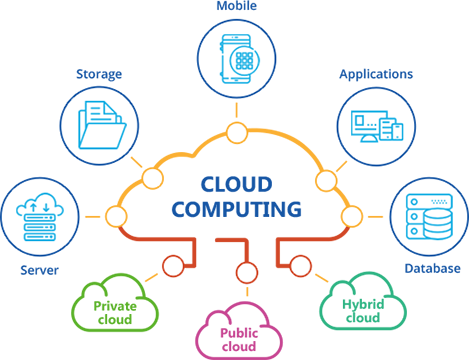Cloud computing is a general term for anything that involves delivering hosted services over the internet, according to techtarget.com.
These services are divided into three main categories or types of cloud computing: infrastructure as a service (IaaS), platform as a service (PaaS) and software as a service (SaaS).
A cloud can be private or public. A public cloud sells services to anyone on the internet.
A private cloud is a proprietary network or a data center that supplies hosted services to a limited number of people, with certain access and permissions settings.
Private or public, the goal of cloud computing is to provide easy, scalable access to computing resources and IT services, techtarget.com says.
Cloud infrastructure involves the hardware and software components required for proper implementation of a cloud computing model. Cloud computing can also be thought of as utility computing or on-demand computing.
The name cloud computing was inspired by the cloud symbol that’s often used to represent the internet in flowcharts and diagrams.
How does cloud computing work?
Cloud computing works by enabling client devices to access data and cloud applications over the internet from remote physical servers, databases and computers.
An internet network connection links the front end, which includes the accessing client device, browser, network and cloud software applications, with the back end, which consists of databases, servers and computers. The back end functions as a repository, storing data that is accessed by the front end.
Communications between the front and back ends are managed by a central server. The central server relies on protocols to facilitate the exchange of data.
The central server uses both software and middleware to manage connectivity between different client devices and cloud servers. Typically, there is a dedicated server for each individual application or workload.
Cloud computing relies heavily on virtualization and automation technologies. Virtualization enables the easy abstraction and provisioning of services and underlying cloud systems into logical entities that users can request and utilize.
Automation and accompanying orchestration capabilities provide users with a high degree of self-service to provision resources, connect services and deploy workloads without direct intervention from the cloud provider’s IT staff.
Types of cloud computing services
Cloud computing can be separated into three general service delivery categories or forms of cloud computing:
IaaS: IaaS providers, such as Amazon Web Services (AWS), supply a virtual server instance and storage, as well as application programming interfaces (APIs) that let users migrate workloads to a virtual machine (VM).
Users have an allocated storage capacity and can start, stop, access and configure the VM and storage as desired. IaaS providers offer small, medium, large, extra-large, and memory- or compute-optimized instances, in addition to enabling customization of instances, for various workload needs. The IaaS cloud model is closest to a remote data center for business users.
PaaS: In the PaaS model, cloud providers host development tools on their infrastructures. Users access these tools over the internet using APIs, web portals or gateway software.
PaaS is used for general software development, and many PaaS providers host the software after it’s developed. Common PaaS products include Salesforce’s Lightning Platform, AWS Elastic Beanstalk and Google App Engine.
SaaS: SaaS is a distribution model that delivers software applications over the internet; these applications are often called web services. Users can access SaaS applications and services from any location using a computer or mobile device that has internet access. In the SaaS model, users gain access to application software and databases.
One common example of a SaaS application is Microsoft 365 for productivity and email services.
(Copyright: techtarget.com)









Comment